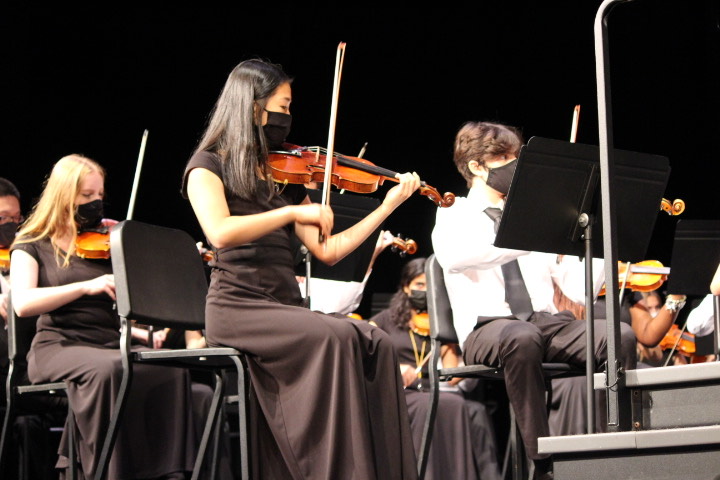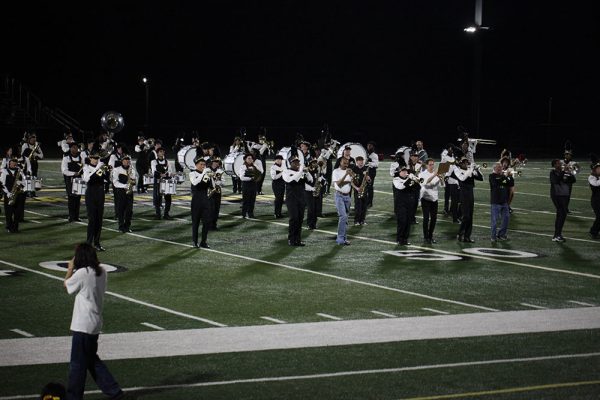Orchestra Features Baroque and Modern Music in Fall Concert
Concertmaster Moonhee Kim is a member of the Cleveland Youth Orchestra and a participant in the Cleveland Institute of Music young artists’ program.
The auditorium was full of family and friends of orchestra musicians on Nov. 3rd for the first in-person concert since 2019.
This will be the last fall performance conducted by orchestra director Lisa Goldman, as she is planning to retire this year.
The lighting and speakers were placed on the stage precisely to avoid obstructing the audience’s view of the orchestra.
When the musicians walked onto the stage and took their seats, excitement and nervousness filled the room.
Senior Moonee Kim was the last to walk out on stage. She is the orchestra’s concertmaster, leader of the first violin section, and she is in charge of directing bowings to the first violin section.
Kim, a member of the Cleveland Youth Orchestra and a participant in the Cleveland Institute of Music young artists’ program, exuded confidence.
As she walked to her chair, the whole orchestra began to stomp their feet, and when she made it to the front, she stroked her bow so the orchestra could follow and tune their instruments.
Capriol Suite by Peter Warlock was the first piece of the night. Written in 1927, the piece is based on a sequence of six Renaissance dances. Each dance in the Capriol Suite has a distinct atmosphere and rhythm.
The first Renaissance dance piece in the Capriol Suite is the Basse-Danse. The somber undertones of the Basse-Danse harmony gave the music depth. The use of contrapuntal rhythms and unison of the strings created some powerful moments and a strong feeling of empowerment.
The second Renaissance dance piece was Pavane. At first, Pavane felt very delicate, slow and solemn. The performance was sensitive and fragile, with a quiet dynamic throughout. However, at the end, the pace of the music races with excitement, but it trickles off into silence shortly after.
The third Renaissance dance piece was Pieds-en-l’air. The warm bass strings drew attention to the tune’s most delicate portions, but the bass strings also supported the lovely upper violin melody. A solo violin appears at the end of the melody, giving it an English pastoral feel.
The last Renaissance dance was Mattachins. This piece consisted of distinct alternating rhythms throughout the performance which made the audience feel as if they were in a sword battle with each contrasting melody indicating swords clashing back and forth. Mattachins, the shortest of the six movements but possibly the liveliest, brings Warlock’s Capriol Suite to a close with enthusiasm and flare.
Sonata Op.1 No 3 by G.F Handel was the second piece of the night. The violin sonatas by Baroque composer George Frideric Handel are shrouded in mystery (1685-1759). Some violin sonatas attributed to Handel have been questioned by musicologists in recent years.
Handel’s Sonata in D Major is structured as a Sonata da chiesa, a baroque instrumental work with several movements; however, the BHS orchestra only played the Allegro.
The violins performed fast rhythmic passages, and the dotted notes combined with sixteenth notes gave this piece a bright, optimistic spirit. Despite the fact that the solo violin had a melodic contour which stood out over the other instruments, the instruments all harmonized together well.
The third performance of the night was Concerto Grosso, Opus 3, No.3 by Antonio Vivaldi, arranged by Lloyd Conely. The Concerto Grosso is a multi-movement performance; however, the BHS orchestra only performed the third.
This Vivaldi piece divides the ensemble into two separate groups while using several soloists rather than just one. The Allegro had a swift movement and a terraced dynamic, fast changes in the volume level that creates an echo effect. In this piece, the cellos had a distinguished tone that almost sounded like a cry out for help, and the violins would come in and save the cellos.
The fourth performance of the night was Fiddle Faddle by Leroy Anderson, which consisted of eight soloists and the orchestra. The soloist in this piece “glowed,” while the orchestra “endorsed the soloist,” making this performance a first-class musical experience. This piece was also a fantastic encore and provided a nice change of pace from the rest of the show as it was less of a baroque style and more modern.
The last performance of the night was Tico-Tico! by Zequinha de Abreu. The stage setup changed for this performance, and instead of sitting, the violins moved their stands to the front and performed side by side at the front of the stage.
De Abreu’s irresistible catchy, aggressively syncopated beat lends itself to virtuosic adaptations for every violinist and the rest of the orchestra, from finger-plucking violin transcriptions to full-on orchestral arrangements and percussion movements. The last performance was exceptional.
The BHS orchestra executed each piece of the night with exquisite coordination and dedication that created an euphonious performance and took the audience to a first-class experience.

Lana Lagman (she/her) began writing for the Beachcomber in the fall of 2020. She likes to cover stories concerning mental health, diversity and new medical/scientific...










![“My parents have always said that education is important. My parents are Chinese immigrants, I'm Chinese American, [and that's a] value that has always been ingrained in our community,” said Senior Lyndia Zheng, pictured with Tony Zheng](https://bcomber.org/wp-content/uploads/2025/10/DSC_4244-600x400.jpg)



Martha Knight • Nov 13, 2021 at 1:52 PM
Wonderful review. Nice programming especially Fiddle Faddle -a favorite by Leroy Anderson along with The Tyewriter. You have done a marvelous job of creating a wonderful string program in Beachwood. Can’t believe you’ll be retiring- it seems like not so long you applied for the job when all they had was a band!